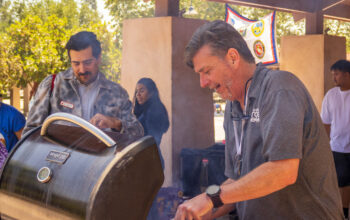A large crowd grew in the stifling Thursday heat, while students restlessly waited to enter the recital hall. Around 1 p.m., the crowd began to shuffle through the doors of MUS 3400 and the room was quickly filled.
Through the hum of low level chatter, associate professor James Bergman walked to the front of the stage. Bergman clapped to gain everyone’s attention and the chatter gradually faded.
“I think today is going to be a pretty cool concert. These guys, they have been here before and I know them from the past,” Bergman said.
When Misaq and Matin Es-haghi stepped onto the stage, a calm fell over the audience.
The Es-haghis are two brothers, who learned traditional Persian music from their father Dariush Es-haghi. The family performs together as the “Koobang Ensemble.”
“Today we have one instrument named the Persian tar, that Matin is playing,” Misaq said.
Martin stood with the instrument on his lap. While leaning it on it’s base, he turned it from side to side to show the audience.
The tar is a six stringed instrument, strung in pairs. It is much like the sitar and played like a guitar.
“It has movable frets because we are [using] quarter tones. When we are in standard play, we change the frets as we play,” Masiq said.
The free concert series isn’t only about the music, they’re also about music education.
To Masiq’s right sat a round wood hand drum, called the tonbak. It’s played using all ten fingers, while resting on the performer’s lap. The finger tapping creates a deep conga drum-like rhythm.
The Es-haghi brothers continued to alternate instruments with each song they performed.
Their phrasing and articulation throughout the concert captured the attention of the entire audience.
Miraq played the kamancheh, which can also be used for meditation. The kamancheh is a string and bow instrument that resonates like a viola, but is played like a small cello.
During the third song Martin played the tar while singing in his native tongue. His brother Misaq continued to play and solo on the kamancheh.
“The song that he sang is a love song. It is about a love being with someone else,” Misaq said.



